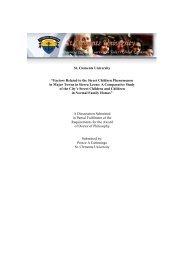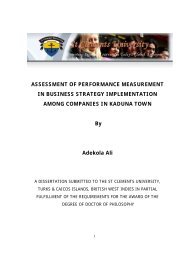The role of informal microfinance institutions in saving
The role of informal microfinance institutions in saving
The role of informal microfinance institutions in saving
Create successful ePaper yourself
Turn your PDF publications into a flip-book with our unique Google optimized e-Paper software.
<strong>in</strong>comes, build assets, and reduce vulnerability. It also translates to better nutrition and<br />
improved health and improved health outcomes. <strong>The</strong>se experiences suggest that provid<strong>in</strong>g<br />
affordable f<strong>in</strong>ancial services to the rural population deserves high priority <strong>in</strong> development.<br />
Direct <strong>in</strong>terventions have failed<br />
Direct <strong>in</strong>terventions <strong>in</strong> rural f<strong>in</strong>ance to stimulate growth and reduce poverty through a blend<br />
<strong>of</strong> targeted credit programmes, <strong>in</strong>terest subsidies, and other government policies became<br />
widespread <strong>in</strong> the 1950s, when Keynesian economics <strong>in</strong>spired many governments to design<br />
fiscal <strong>in</strong>terventions at the macroeconomic level. But these direct <strong>in</strong>terventions have generally<br />
been disappo<strong>in</strong>t<strong>in</strong>g and have tendered to retard, rather than promote the development <strong>of</strong><br />
f<strong>in</strong>ancial services <strong>in</strong> the rural areas.<br />
Institutional and policy Design stands a better chance <strong>of</strong> success<br />
A recent development <strong>in</strong> the provision <strong>of</strong> rural f<strong>in</strong>ancial services ( Both sav<strong>in</strong>gs and credit)<br />
have demonstrated that proper <strong>in</strong>stitutional design and adherence to appropriate policies pays<br />
<strong>of</strong>f handsomely and have the potential to generate substantial achievements <strong>in</strong> terms <strong>of</strong> both<br />
susta<strong>in</strong>ability and greater <strong>in</strong>stitutional outreach. <strong>The</strong>re are an <strong>in</strong>creas<strong>in</strong>g numbers <strong>of</strong> successful<br />
micro-f<strong>in</strong>ance <strong><strong>in</strong>stitutions</strong> that provide f<strong>in</strong>ancial services <strong>in</strong> a susta<strong>in</strong>able manner. Various<br />
quantitative and qualitative studies <strong>in</strong>dicate <strong>in</strong>crease <strong>in</strong> <strong>in</strong>come and assets and decrease <strong>in</strong><br />
vulnerability <strong>of</strong> micro-f<strong>in</strong>ance clients.<br />
Although the new approach focuses on <strong>in</strong>come expansion and poverty reduction, the<br />
perceived challenges and ways <strong>of</strong> address<strong>in</strong>g them are strik<strong>in</strong>gly different. <strong>The</strong> pr<strong>in</strong>cipal change<br />
<strong>in</strong>volves promot<strong>in</strong>g deep and efficient rural f<strong>in</strong>ancial markets by creat<strong>in</strong>g a favorable policy<br />
environment, improv<strong>in</strong>g the legal and regulatory framework that supports rural f<strong>in</strong>ancial<br />
markets and address<strong>in</strong>g specific market failures <strong>in</strong> cost effective ways through well designed,<br />
self susta<strong>in</strong><strong>in</strong>g <strong>in</strong>terventions. Successful rural f<strong>in</strong>ance <strong><strong>in</strong>stitutions</strong> are all located near their<br />
clients; utilize lend<strong>in</strong>g technologies that are simple and <strong>in</strong>expensive for both the client and<br />
lender and most <strong>in</strong>clude sav<strong>in</strong>gs.<br />
64
















